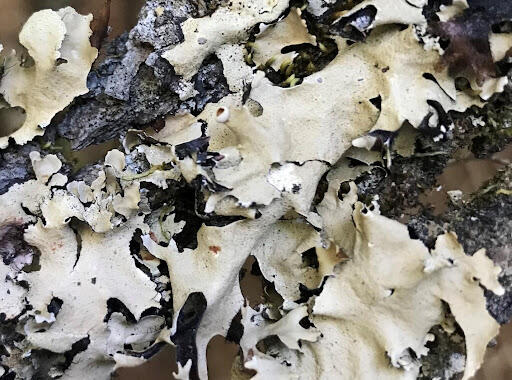







Loading profile. Please wait . . .
Parmotrema cetratum (Ach.) Hale
Fertile Cracked-ruffle




Federal Protection: No US federal protection
State Protection: No Georgia state protection
Global Rank: G5?
State Rank: SNR
Element Locations Tracked in Biotics: No
SWAP 2015 Species of Greatest Conservation Need (SGCN): No
SWAP 2025 Species of Greatest Conservation Need (SGCN): No
2025 SGCN Priority Tier: None
Element Occurrences (EOs) in Georgia: 0
Habitat Summary for element in Georgia: Upland woodlands, forests
Pale green-gray thallus of broad (1cm wide) main lobes & strap-like side lobes 1-2 mm wide; lobe surfaces covered with dense, reticulate pattern of minute cracks; undersides brown at lobe edges, black in center, with dense growth of long rhizines to lobe edges; lobes with abundant, long black cilia; apothecia common to rare (look for tiny buds on thallus surface), brown cups, with or without central perforation; CHEMISTRY: medulla K+ blood red (salazinic acid); FIELD ID: given abundance of Parmotrema perforatum complex & P. submarginale, take care to check undersides for color & position of rhizines, & upperside for reticulate cracks
Rare Parmotrema despectum is similar in size & chemically, but its undersides lack rhizines in a broad zone near edges; P. perforatum is larger, with broad white edges to undersides & no rhizines near lobe edges; P. submarginale lacks cracked upper surface, has no perforations on apothecia, lacks rhizines near lobe edges, & its medulla is K- (see key below)
None
Upland woodlands & forests, on hardwood bark, mostly Quercus & Acer
Corticolous foliose lichenized fungus, photobiont a green alga (Trebouxia?)
None
Mostly Piedmont & Southern Blue Ridge, with a few scattered occurrences in Coastal Plain
Unknown
Rare
None
Brodo, I. M. 2001. Lichens of North America. Yale University Press, New Haven, Conn.
Brodo, I. M. 2016. Keys to lichens of North America: revised and expanded. Yale University Press, New Haven, Conn.
Esslinger, T. L. 2021. A cumulative checklist for the lichen-forming, lichenicolous and allied fungi of the continental United States and Canada. Version 24. Opuscula Philolichenum 20: 100-394.
Malcolm Hodges
24 May 2022